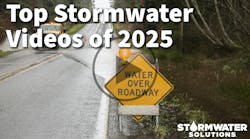About the author: David Ward, CPESC, CESSWI, is executive director for EnviroCert Intl. Ward can be reached at 828.655.1600 or by e-mail at [email protected]. Caitlin Cunningham is managing editor of Storm Water Solutions. Cunningham can be reached at 847.391.1025 or by e-mail at [email protected].
In the fast-paced world of storm water, certification and continuing education programs offer industry professionals the know-how and competitive edge they need to prosper. But in light of tightening company budgets and with a list of acronyms to decipher, how to determine which program best suits one’s needs? To help provide answers, Storm Water Solutions Managing Editor Caitlin Cunningham discussed the ins and outs of certification with EnviroCert Intl. Executive Director David Ward, CPESC, CESSWI.
Caitlin Cunningham: What certification opportunities are available to today’s storm water professional? Please explain.
David Ward: The Certified Professional in Erosion and Sediment Control (CPESC) provides professional credentials for those individuals who deal with construction site erosion and sedimentation from a design, implementation, maintenance or regulatory point of interest.
The Certified Professional in Storm Water Quality (CPSWQ) provides professional credentials for those who deal with both construction and post-construction storm water from a design, implementation, maintenance or regulatory point of view.
The Certified Erosion, Sediment and Storm Water Inspector (CESSWI) provides credentials for site inspectors checking for Phase II compliance.
Cunningham: How does one apply for a certification program?
Ward: The application process is one that requires prior approval to take the exam. An application includes personal information, educational information, work experience and references. Applications can be found on the website for each certification: www.cpesc.org, www.cpswq.org and www.cesswi.org.
Cunningham: What amount of time, money and maintenance should a would-be certified professional expect to put into a program?
Ward: The application review process takes about three weeks. Application review fees can be found on the website for each certification. Professional development units (PDUs) are required on all certifications. For the CPESC and CPSWQ, we require 60 PDUs every three years. For the CESSWI, we require 10 each year.
Cunningham: Any suggestions for preparing for a certification exam?
Ward: Most individuals preparing for an exam use the specified exam review study guides, which contain information from which we get our questions for the exam. Some have used the TR-55 process developed by the U.S. Department of Agriculture as an additional help for the CPESC’s runoff and sediment calculation section. There are various other books available that can assist in this. Most jurisdictions now have a design manual for use in their area that will likely aid in passing an exam.
Cunningham: Where and when are the exams offered?
Ward: Classes and exams are provided on a demand basis. If someone wishes to look into sponsoring a class or an exam, they should contact our office.
Cunningham: Why invest in earning one or more of these titles?
Ward: There are several reasons to invest in a certification program: to enhance your professional credibility; achieve greater marketability of available services; promote public awareness of the erosion, sediment control and storm water professions; have greater influence on policy decisions affecting technical and professional issues; gain access to unique sources of information and educational opportunities; and for professional liability insurance.
Download: Here

